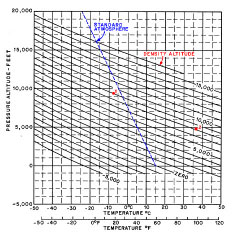 |
||||||||
|
||||||||
|
A
Monthly Safety Bulletin from The Office of the NASA Aviation Safety
Reporting System
P.O. Box 189, Moffett Field, CA 94035-0189 |
||||||||
|
|
||||||||
 |
||||||||
|
||||||||
|
A
Monthly Safety Bulletin from The Office of the NASA Aviation Safety
Reporting System
P.O. Box 189, Moffett Field, CA 94035-0189 |
||||||||
|
|
||||||||
Density
Altitude 
As summer approaches, temperatures increase and density altitude becomes an important consideration for pilots. High density altitude can affect aircraft in several ways. Wing or rotor lift is decreased. Engine power is reduced. Propeller, rotor, and jet engine thrust are decreased. Degraded aircraft performance results in increased takeoff distance, reduced rate of climb, increased true airspeed on approach and landing, and increased landing roll distance.
Precise calculation of performance data and strict adherence to Pilot's Operating Handbook (POH) procedures are critical for high density altitude operations.
Squeeze Play
This instructor and student used the POH to calculate the rotation speed but neglected to follow the procedure for leaning the fuel mixture. They put their C172 into a spot where there was not enough speed to takeoff and not enough runway left to abort.
In general, when the density altitude exceeds 5,000 feet, normally aspirated engines should be leaned for optimum performance. Follow the POH procedures for specific aircraft and engines.
High, Heavy, Fast, and Fortunate
If an aircraft is operating at the edge of its performance at a high density altitude there is no room for error- even in the cool of the night.
Heavyweight Joins Wheat Watchers
"Oops! Let's try that again," is not something you want to hear from your surgeon. And, as a passenger of a light aircraft departing a high altitude airport, it is not something you want to hear from the pilot after he takes off and settles into a wheat field.
Field Maneuvers
Even a powerful World War II training aircraft can have a hard time when a soft runway is combined with a high density altitude.
Editor's note:
Scott Gardiner of the FAA's Seattle Flight Standards District Office has published an excellent review based upon the density altitude seminars given by National Transportation Safety Board (NTSB) Accident Investigator Kurt Anderson. The article was printed in the May/June FAA Aviation News which is available at: http://www.faa.gov/AVR/afs/news/
Controller's Corner
Enhance Your Image
Flight following, although not mandatory, is certainly recommended for aircraft operating VFR in or near congested airspace. A request for flight following alerts ATC to the presence of an aircraft which may not be apparent on radar and can enable traffic advisories (controller workload permitting) to be given to the pilot. If a transponder is required for the airspace in question, then it is incumbent upon the pilot to ensure that the unit is operational and activated. The airborne TCAS (Traffic Alert and Collision Avoidance System) also relies upon transponder signals to identify traffic conflicts. Use of flight following and/or activation of a transponder by the Cessna in this incident could have prevented a Near Mid-Air Collision (NMAC).
At no time did the target display a transponder code.
A better radar return on the Cessna certainly would have helped, but the heavy concentration of traffic and several other aircraft in the immediate area cluttered the radar presentation so much that just seeing all the data blocks, let alone stray traffic, became difficult. Even more important, as a controller and pilot, I feel that flying the route and altitude the Cessna took over a major air traffic area was not consistent with good planning and procedures unless the pilot had used Flight Following from ATC.
I know that many pilots think ATC can see them, but if their transponder is not working properly, we won't see them and they won't know it. Perhaps this could be addressed at the FAA's pilot briefings or in biennial flight reviews.
Cabin Report
Say Good-bye to Trouble
In the event that inebriated passengers manage to get through the boarding process, sharp cabin crews can prevent in-flight disruptions by removing them before takeoff.
From the Maintenance Desk
Cap It!
Judging from the number of reports submitted to ASRS, the problem of missing or improperly secured engine oil caps is still a concern. Let's get the word out and put a cap on this problem.
|
ASRS Recently Issued Alerts On...
|
|---|
| B737-200 flap carriage spindle failure |
| Eurocopter 120B main gearbox oil loss |
| C750 elevator control cable interference |
| Faded runway hold short lines at a foreign airport |
| Inadequate taxiway markings at a southern U.S. airport |
|
April 2004 Report Intake
|
|
|---|---|
| Air Carrier/Air Taxi Pilots |
2,194
|
| General Aviation Pilots |
757
|
| Controllers |
37
|
| Cabin/Mechanics/Military/Other |
94
|
| TOTAL |
3,082
|